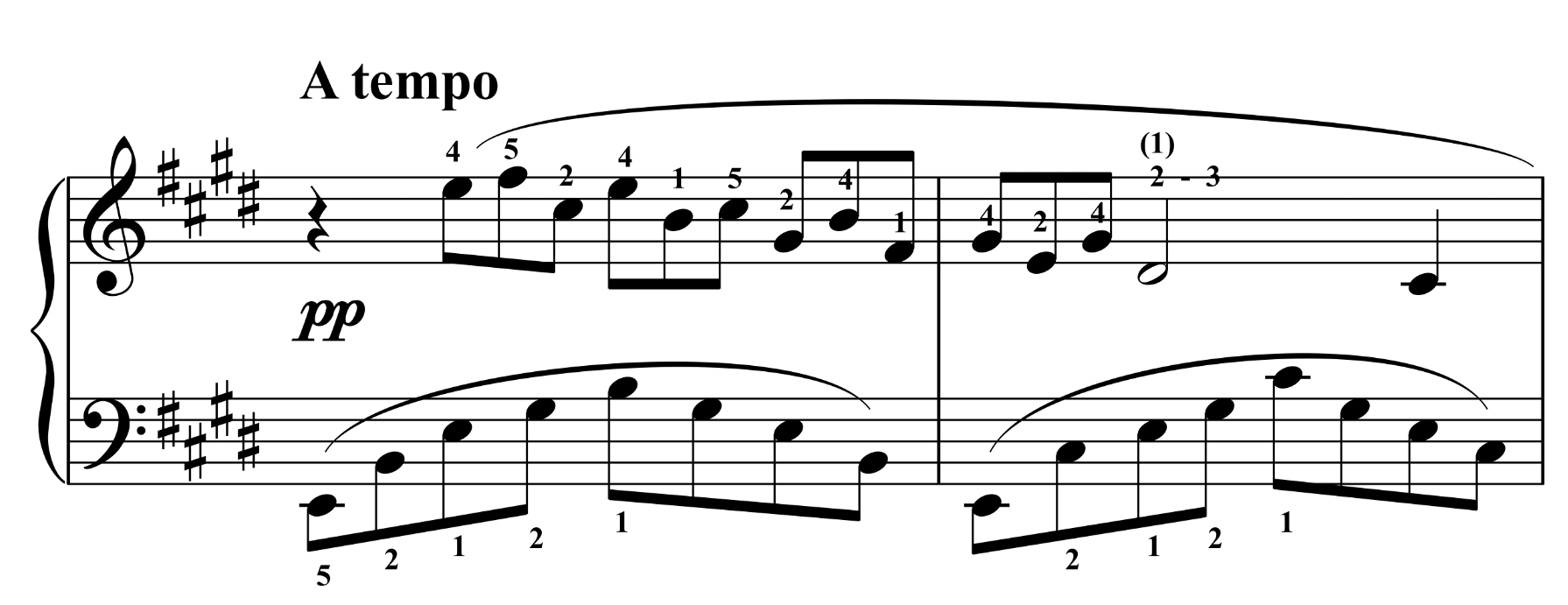“The fingering for this passage works best for me when I break it into three positions of four notes each.”
Submitted by Michael Clark
Published on 7/30/2021

“The fingering for this passage works best for me when I break it into three positions of four notes each.”
Submitted by Michael Clark
Published on 7/30/2021

“I find it more comfortable to let the right hand take over the arpeggio earlier.”
Submitted by Michael Clark
Published on 7/30/2021

“I use this fingering because it allows the right hand to stay in a relatively close position. Playing the right-hand thumb on the first note of each fragment, which is an undershape up to the fifth finger, causes the elbow to have to move further and more precipitously from left to right than the 1 2 5 undershape. The overshape from the top note down to the thumb doesn’t cause the arm to move as much. This is very important in the very quick tempo of this piece. In addition, it is closer to move the thumb from the last thumb up to the top note. And lastly, taking the first note of the fragment with the left hand allows the right hand one extra note to complete the movement up to the top note.”
Submitted by Deborah Cleaver
Published on 1/2/2022

“It’s much easier to catch the melodic figure in the RH because the LH will not have to travel so far at a very fast tempo.”
Submitted by Josh Condon
Published on 4/29/2020

“I find that I have more control over the triplets in m. 19 when I use 4-3-2-1. I play the G with the left hand which helps give it a distinct articulation. I use one pedal for all of m. 19.”
Submitted by Michael Clark with thanks to Nancy Weems
Published on 1/1/2020

“Uncrossing the hands two beats early enables a smoother transition to the next gesture.”
Submitted by Michael Clark
Published on 1/1/2020
Original:

Suggested performance:

“Starting the trills with the left-hand thumb gives brilliance.”
Submitted by Michael Clark with thanks to Nancy Weems
Published on 1/1/2020

“These three notes can be easily incorporated into the left hand, allowing the right hand to move to the higher register.”
Submitted by Michael Clark
Published on 1/1/2020

“I like to take a few extra notes in the in left hand.”
Submitted by Michael Clark
Published on 1/1/2020

“I’ve always found this right-hand run difficult to play accurately. Taking these two notes with the left hand (while the lower notes are sustained with the pedal) helps me negotiate the position shifts more easily.”
Submitted by Michael Clark
Published on 7/30/2021

“Letting the left hand thumb start the final group of triplets allows a more comfortable fingering for the remainder of the passage.”
Submitted by Michael Clark
Published on 7/30/2021

“Taking the first note of this gesture in the left hand eliminates the wide stretch.”
Submitted by Michael Clark with thanks to Craig Nies
Published on 1/1/2020

“Taking the top of the gesture in the right hand in m. 50 increases brilliances. I find that taking more notes in the right hand in m. 53 is more reliable for me.”
Submitted by Michael Clark
Published on 1/1/2020

“The highest note of the left-hand arpeggio fits easily within the right-hand chord, eliminating awkward crowding between the hands.”
Submitted by Michael Clark
Published on 7/30/2021

“I find dividing this arpeggio more evenly between the hands gives me more control at this dynamic.
Submitted by Michael Clark
Published on 1/1/2020

“Striking the half-note F with the left hand helps me give each motive a distinct sound.”
Submitted by Michael Clark
Published on 7/30/2021

“Taking the C-sharp in the left hand eliminates a position shift in the right hand.”
Submitted by Michael Clark
Published on 1/1/2020

”I find descending broken octaves, especially those that range multiple octaves and cross the body, difficult to execute. With this redistribution, I alternate hands to play the D# (an easy key to find quickly, since it's a black key). I find that I can still retain the quality of the two-note slur, even with this redistribution.”
Submitted by Sarah Rushing
Published on 2/20/2020